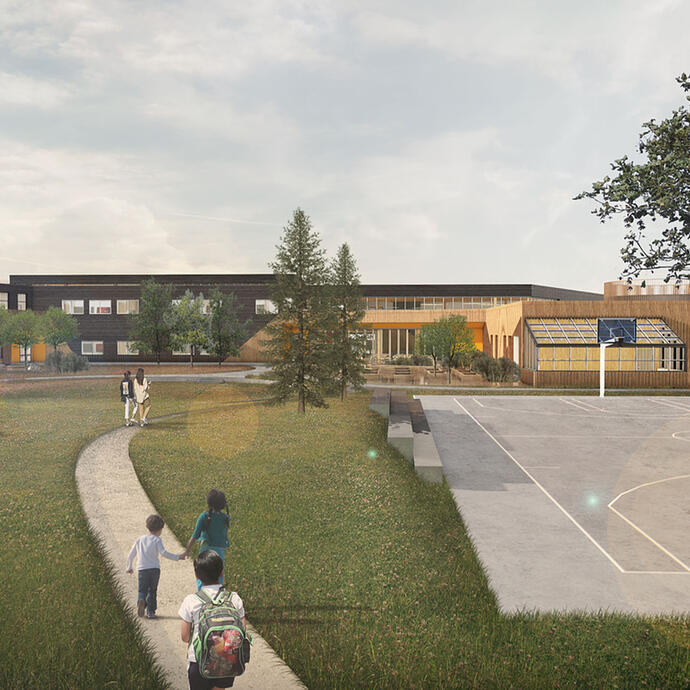Located in Southern Alberta, the new Aahsaopi Elementary School is replacing a 30-year old existing building. The design of the new building is grounded in Blackfoot Culture and will be a key part of the Kainai Nation community. It is planned to support upwards of 500 students from kindergarten to grade five, and lead the way for other schools in Southern Alberta to target ambitious sustainability initiatives.
Smith + Andersen Associate Robert Gliddon (mechanical design) is one of many consulting team members contributing to this new Elementary School. Our team is working alongside Reimagine Architects, as well as the local community, the Kainai Board of Education, the Blood Tribe Chief, and Indigenous Services Canada. For Robert, this project opportunity has been filled with learning opportunities, including a greater understanding of Canadian history, and invaluable lessons surrounding the path to Truth and Reconciliation.

How did you prepare to be part of this project?
ROBERT:
Aahsaopi Elementary School was entering its early planning phases in 2021, around the time several unmarked graves at former residential schools were discovered. The findings were reported across several news channels and consistently referenced in my social circles. It was a combination of natural exposure and knowing I’d be working on the project, that sparked my deep-dive into research on the topic. Knowing collaboration would be at the forefront of the design approach, I wanted to be educated enough to have insightful contributions to the conversations. Encouraged by the project team, I began researching this increasingly prevalent topic, and immediately stumbled upon the Truth and Reconciliation of Canada: Calls to Action. This list includes 94 action items the Truth and Reconciliation Commission put together, and as I was reading through it, I was shocked… most people would consider a lot of what they’re asking for in this list to be basic human rights! I’m confident that anyone reading through the Calls to Action for the first time would have had a similar reaction.
I think we have a responsibility, as engineers who are working on Indigenous projects and, honestly, as Canadians who live in this country, to educate ourselves on the atrocities that took place at residential schools. It’s an uncomfortable topic and an extremely shameful part of our history, but considering that Aahsaopi Elementary is a place for education, it is especially important to understand this dark past.
What has it been like working on this project?
ROBERT:
Beyond this initial research, working with Reimagine Architects has furthered my learning experience. Their firm has a long history of designing with Indigenous communities, and they are well-educated on the histories that are critical to designing buildings for these communities. Before Smith + Andersen got involved in the project, a lot of the preliminary stages of the project included coordination between Reimagine, the community, the Kainai Board of Education, the Blood Tribe Chief, and Indigenous Services Canada. After Smith + Andersen became involved, this collaboration continued.
The consultant team wanted to make sure the community’s representatives had authority and autonomy in the discussions. For example, there were a lot of meetings throughout the project process with the individual who will maintain and operate Aahsaopi Elementary. Located on Kainai First Nations land with the nearest large town more than two hours away, the Operations and Maintenance Supervisor for The Kainai Board of Education continually stressed the importance of designing robust solutions with parts that would be readily available. Every good design seeks consultation from the end-user, and Indigenous projects are no exception.
What’s something that surprised you during the project process?
ROBERT:
While respect for the environment is definitely a cultural narrative in Indigenous communities, and some Kainai First Nation community members wanted to prioritize sustainability, there was also a solid amount of hesitation that came with introducing systems that the community perceived as novel or overly specialized. I was surprised at the diverse array of opinions on the matter, but quickly came to understand that while sustainability was an important focus for the project, there was also a significant business component attached. As a result, we had to make a lot of business cases and, like many projects, persuade stakeholders from an economic standpoint.
For example, to make a case for the geothermal system we wanted to implement, we demonstrated similar institutions in the northwest United States (a similar climate) that had used the system successfully. While some of the sustainability designs needed to achieve the net zero targets may have been considered “newer” in the southwestern Alberta region, we demonstrated that the systems we were incorporating were reliable. Aahsaopi’s design isn’t the first to incorporate these technologies, and hopefully won’t be the last – setting a precedent for other elementary schools to follow suit with ambitious initiatives in the future.
What are some of your biggest takeaways from this project?
ROBERT:
I’m proud to work on a project like Aahsaopi Elementary School – a design that provides a window into making genuine progress towards Truth and Reconciliation. We are creating a physical example of a building that will provide equitable access to education for future youth and, hopefully, repair a small fraction of the knowledge that was lost during the former residential school atrocities. Aahsaopi is a tangible example of not just putting words to paper, but actually putting actions to our words. Referring back to the Calls to Action, items six through 12 in the list are based entirely on promoting education opportunities, and Aahsaopi Elementary demonstrates progress towards this commitment.
It has been amazing to work with Reimagine, the community, the Elders, and all the project parties that have been involved. There’s a serious undertone to the importance of the project, but it’s met with a lot of enthusiasm from the consulting team and the community. There’s a long way to go on the journey to Truth and Reconciliation, but this elementary school (and many of the educational centres following suit) represents progress.
Robert Gliddon is an Associate based out of our Calgary office. He is a trusted leader with more than a decade of experience designing mechanical solutions across western Canada. Read his full bio HERE .
Aahsaopi Elementary School is currently under construction and Smith + Andersen is providing mechanical engineering design services for the new building. Read more about the project design HERE .



